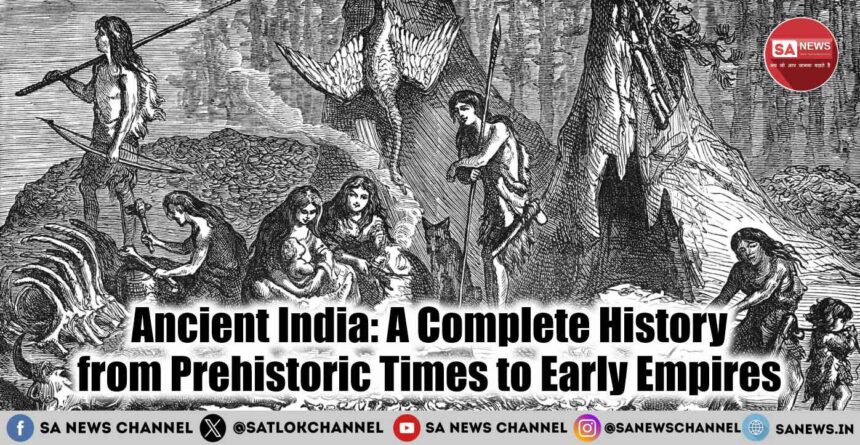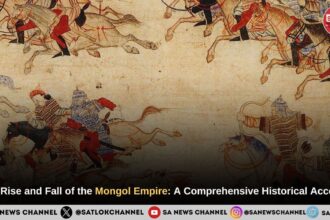Discover the rich history of Ancient India, from the Indus Valley Civilization to the Golden Age of the Gupta Empire. Learn about its contributions to mathematics, trade, religion, and governance in this in-depth historical guide.
- Discover the Glory of Ancient India
- 1. Prehistoric Period of India (Up to 2500 BCE
- 1.1 Paleolithic Age (Old Stone Age) – 2.5 Million BCE to 10,000 BCE
- 1.2 Mesolithic Age (Middle Stone Age) – 10,000 BCE to 8,000 BCE
- 1.3 Neolithic Age (New Stone Age) – 8,000 BCE to 2,000 BCE
- 2. The Indus Valley Civilization (3300 BCE – 1300 BCE)
- 2.1 Major Cities and Features
- 2.2 Society and Culture
- 3. Vedic Period (1500 BCE – 600 BCE)
- 3.1 Early Vedic Age (1500 BCE – 1000 BCE)
- 3.2 Later Vedic Age (1000 BCE – 600 BCE)
- 4. Mahajanapadas and Rise of Kingdoms (600 BCE – 321 BCE)
- 4.1 Important Mahajanapadas
- 4.2 Religious and Philosophical Developments
- 5. The Maurya Empire (321 BCE – 185 BCE)
- 5.1 Chandragupta Maurya (321 BCE – 297 BCE)
- 5.2 Ashoka the Great (268 BCE – 232 BCE)
- 6. The Gupta Empire (319 CE – 550 CE): The Golden Age
- 6.1 Achievements of the Gupta Age
- 6.2 Decline of the Gupta Empire
- 7. Post-Gupta Period and Early Medieval India (550 CE – 1200 CE)
- 7.1 Harsha Empire (606 CE – 647 CE)
- 7.2 South Indian Dynasties
- Ancient India: Foundations of Civilization and Intellectual Brilliance
- Spiritual Insights on Ancient India Through Sant Rampal Ji Maharaj’s Teachings
- Understanding Ancient India’s Spiritual Truth
- (FAQs) about the history of Ancient India
- 1. What were the major civilizations of Ancient India?
- 2. What were the key contributions of Ancient India to the world?
- 3. How did Ancient India’s trade and economy function?
- 4. What were the major religions that originated in Ancient India?
- 5. What led to the decline of Ancient Indian empires?
- Connect With Us on the Following Social Media Platforms
Discover the Glory of Ancient India
Ancient India is one of the world’s oldest civilizations, with a history spanning thousands of years. It has contributed significantly to philosophy, mathematics, literature, and governance. The land of India has seen the rise and fall of many powerful civilizations, from the Indus Valley Civilization to the grand Maurya and Gupta Empires. Ancient Indian culture was deeply rooted in spiritual traditions, social structures, and scientific advancements. The concept of Dharma (duty) and Karma (action and consequences) played a crucial role in shaping its society. Great scholars like Aryabhata, Patanjali, and Chanakya made significant contributions to science and governance.
Ancient India’s achievements in architecture, metallurgy, and medicine were advanced for their time. In this article, we will explore the major historical phases of ancient India, from prehistoric times to early medieval empires, covering their achievements, culture, rulers, and impact on human civilization.
1. Prehistoric Period of India (Up to 2500 BCE
The Prehistoric Period of India (up to 2500 BCE) refers to the time before written records were available. It is divided into different stages based on technological and cultural advancements:
1.1 Paleolithic Age (Old Stone Age) – 2.5 Million BCE to 10,000 BCE
The Paleolithic Age is the earliest known phase of human existence in India. People of this period were hunter-gatherers who relied on nature for their survival. They used basic stone tools, such as hand axes and scrapers, to hunt animals and cut food. The discovery of fire allowed early humans to cook food, keep warm, and protect themselves from wild animals. Bhimbetka Rock Shelters, located in present-day Madhya Pradesh, have prehistoric cave paintings that provide insights into their daily life, hunting techniques, and rituals.
These cave drawings depict animals, human figures, and dance scenes, indicating that early humans had a basic understanding of art and communication. The Paleolithic Age was a crucial period in human evolution, as it marked the beginning of tool-making, which later led to advancements in farming and settlement-building.
1.2 Mesolithic Age (Middle Stone Age) – 10,000 BCE to 8,000 BCE
The Mesolithic Age marked a transition from the hunter-gatherer lifestyle to early forms of agriculture. People began domesticating animals such as dogs, sheep, and goats, which helped them with hunting and food production. Unlike the previous period, tools became more refined, with the introduction of microliths—small, sharp stone tools used for hunting and crafting. This period also saw the development of fishing techniques, as people started living near rivers and lakes.
■ Also Read: The History of Africa: Ancient Civilizations to Modern Innovations
Rock art and cave paintings from this era, particularly in Bhimbetka, depict human settlements, rituals, and social interactions, suggesting that early humans had begun forming organized communities. The Mesolithic period set the foundation for farming and permanent settlement, which played a vital role in the later development of civilizations.
1.3 Neolithic Age (New Stone Age) – 8,000 BCE to 2,000 BCE
The Neolithic Age marked a significant shift in human civilization, as people started practicing agriculture and forming permanent settlements. Crops like wheat, barley, and rice were cultivated, and animals such as cattle and sheep were domesticated for food and labor. Pottery-making, weaving, and trade began, leading to a more structured society. The Mehrgarh site in present-day Pakistan is one of the earliest Neolithic settlements, showing evidence of early farming, cattle rearing, and pottery production.
Housing structures became more advanced, with mud-brick houses replacing temporary shelters. The introduction of wheel technology allowed for the development of transportation and pottery-making techniques. Social structures started forming, as different groups specialized in farming, tool-making, and trade. The Neolithic Age was a crucial step towards civilization, as it led to the establishment of large settlements, which eventually evolved into great cities and kingdoms.
2. The Indus Valley Civilization (3300 BCE – 1300 BCE)
The Indus Valley Civilization (IVC), also known as the Harappan Civilization, was one of the world’s earliest and most advanced urban civilizations. It flourished along the Indus River in present-day Pakistan and northwestern India. The civilization is known for its planned cities, drainage systems, and sophisticated architecture.
2.1 Major Cities and Features
The two most prominent cities of the Indus Valley Civilization were Harappa and Mohenjo-Daro. These cities featured:
- Well-planned streets laid out in a grid pattern, suggesting advanced urban planning.
- Multi-storied brick houses, showing early engineering skills.
- Underground drainage systems, which were more advanced than many later civilizations.
- Public granaries for storing food.
- Lothal, an important port city, played a crucial role in maritime trade with Mesopotamia and Egypt.
- Dholavira, another major site, showcased a unique water conservation system, demonstrating the civilization’s engineering expertise.
2.2 Society and Culture
The Harappan people were skilled traders, farmers, and artisans. They used a unique script, which remains undeciphered, and seals with animal motifs, possibly for trade. Archaeological evidence suggests they practiced worship of nature, fertility gods, and proto-Shiva figures. The civilization had a high standard of hygiene, as evident from their well-planned drainage systems and public baths. Trade with Mesopotamia, Persia, and Central Asia was well established. The decline of the Indus Valley Civilization around 1300 BCE is believed to have been caused by climate change, river shifts, or possible Aryan invasions.
3. Vedic Period (1500 BCE – 600 BCE)
The Vedic Period is named after the Vedas, the oldest Hindu scriptures composed in Sanskrit. The Vedas—Rigveda, Yajurveda, Samaveda, and Atharvaveda—form the foundation of Hindu religious and social life. This period is divided into the Early Vedic Age (1500 BCE – 1000 BCE) and the Later Vedic Age (1000 BCE – 600 BCE).
3.1 Early Vedic Age (1500 BCE – 1000 BCE)
The Rigveda, composed during this time, contains hymns dedicated to various Vedic gods such as Indra (God of Thunder), Agni (Fire God), and Varuna (God of Cosmic Order). Society was mostly pastoral, with cattle being the primary measure of wealth. People lived in small tribal groups, each ruled by a Raja (king). The economy depended on cattle rearing, agriculture, and trade. Women had a respectable position and participated in religious ceremonies. There were no rigid social divisions, and people lived relatively simple lives.
3.2 Later Vedic Age (1000 BCE – 600 BCE)
During this period, society transitioned from a tribal system to a monarchy. The caste system became more rigid, dividing society into Brahmins (priests), Kshatriyas (warriors), Vaishyas (merchants), and Shudras (laborers). Agriculture improved with iron plows and irrigation techniques. The Upanishads, composed during this time, introduced philosophical concepts like karma, dharma, and moksha. Kings ruled with the help of councils, and large kingdoms started emerging.
4. Mahajanapadas and Rise of Kingdoms (600 BCE – 321 BCE)
During this period, India witnessed the rise of Mahajanapadas, which were large political entities or states. There were 16 major Mahajanapadas, each with distinct governance and military strategies. The most powerful among them included Magadha, Kosala, Vatsa, and Avanti. These kingdoms played a crucial role in shaping India’s political and economic landscape.
4.1 Important Mahajanapadas
- Magadha – The most dominant kingdom, known for its military strength and rulers like Bimbisara and Ajatashatru. It later became the center of the Mauryan Empire.
- Kosala – The birthplace of Lord Rama, located near present-day Ayodhya. It had strong cultural and religious influences.
- Vatsa and Avanti – These kingdoms were major trade hubs and contributed to India’s growing wealth.
- Trade flourished during this time, with merchants traveling between India and Persia, Mesopotamia, and Southeast Asia. The development of coin-based currency helped boost commerce.
4.2 Religious and Philosophical Developments
The period also saw the rise of two significant religious movements: Buddhism and Jainism. These faiths emerged as reactions to Brahmanical rituals and social inequalities in the Vedic system.
- Buddhism: Founded by Gautama Buddha, it emphasized the Four Noble Truths and the Eightfold Path as a means to attain enlightenment.
- Jainism: Founded by Mahavira, it focused on Ahimsa (non-violence), Aparigraha (non-possessiveness), and Satya (truthfulness).
- Both religions gained immense popularity, especially among merchants and the lower castes, as they rejected rigid caste divisions. The establishment of monastic communities and universities like Takshashila helped spread knowledge, philosophy, and education throughout India.
5. The Maurya Empire (321 BCE – 185 BCE)
The Maurya Empire was the first to unify most of India under a single rule. Established by Chandragupta Maurya after overthrowing the Nanda Dynasty, it became one of the largest empires in the ancient world.
5.1 Chandragupta Maurya (321 BCE – 297 BCE)
- Chandragupta defeated Seleucus I, a Greek general of Alexander the Great, and expanded his empire across northern and central India.
- He was guided by Chanakya (Kautilya), a brilliant strategist and author of Arthashastra, an ancient treatise on statecraft, economy, and military strategy.
- Chandragupta established a centralized administration, with a strong taxation system and an extensive network of roads and trade routes.
- Later in life, he embraced Jainism and renounced his throne, spending his final years in Shravanabelagola as an ascetic.
5.2 Ashoka the Great (268 BCE – 232 BCE)
- Ashoka, the grandson of Chandragupta, is considered one of the greatest rulers in Indian history.
- After witnessing the horrors of the Kalinga War, he abandoned military conquests and adopted Buddhism, promoting peace and non-violence.
- Ashoka issued edicts inscribed on stone pillars and rocks, spreading messages of dharma (moral duty), animal welfare, and religious tolerance.
- He sent Buddhist missionaries to Sri Lanka, China, and Southeast Asia, helping spread Buddhism beyond India.
- His Pataliputra-based administration introduced an efficient judicial system and promoted social welfare programs.
- The Mauryan Empire began to decline after Ashoka’s death due to weak successors and internal conflicts.
6. The Gupta Empire (319 CE – 550 CE): The Golden Age
The Gupta Dynasty marked the Golden Age of India, a period of unparalleled progress in science, literature, arts, and mathematics. The rulers of this empire brought political stability and encouraged education, trade, and culture.
6.1 Achievements of the Gupta Age
- Mathematics: The great mathematician Aryabhata introduced the concept of zero and calculated the value of pi.
- Astronomy: Indian scholars proposed that the Earth rotates on its axis.
- Medicine: The Sushruta Samhita, written by Sushruta, described surgical procedures, including plastic surgery.
- Literature and Arts: The poet Kalidasa wrote famous Sanskrit works like Shakuntala and Meghaduta.
- Trade and Economy: India became a major exporter of spices, silk, and precious stones, trading with Rome, Persia, and China.
6.2 Decline of the Gupta Empire
The empire declined due to internal conflicts, weak rulers, and invasions by the Hunas (White Huns) from Central Asia. By 550 CE, the Gupta Empire had fragmented into smaller kingdoms.
7. Post-Gupta Period and Early Medieval India (550 CE – 1200 CE)
After the fall of the Gupta Empire, India saw the rise of regional powers such as the Harsha Empire, Chalukyas, Rashtrakutas, and Pallavas. These dynasties contributed to temple architecture, philosophy, and trade.
7.1 Harsha Empire (606 CE – 647 CE)
Ruled by Harsha Vardhana, this empire controlled north India and promoted Buddhism and learning.
Nalanda University, a famous center of learning, flourished under Harsha’s rule.
The empire declined after Harsha’s death due to internal rebellions and attacks from regional kings.
7.2 South Indian Dynasties
The Cholas, Cheras, and Pandyas dominated South India, developing maritime trade with China and Southeast Asia. The Brihadeeswarar Temple in Tamil Nadu, built by the Cholas, remains an architectural marvel.
Ancient India: Foundations of Civilization and Intellectual Brilliance
Ancient India’s history is a testament to human progress, scientific discovery, and cultural richness. From the well-planned Indus Valley Civilization to the intellectual achievements of the Gupta Empire, India played a key role in shaping world history. The rise of Buddhism and Jainism, the development of mathematics and astronomy, and the strategic governance of Mauryan rulers set a strong foundation for future generations. The golden age under the Guptas led to remarkable advancements in science, literature, and trade, making India a hub of global knowledge.
Even after the fall of great empires, the cultural and intellectual legacy of ancient India continued to influence later dynasties and civilizations worldwide. Understanding ancient India’s history helps appreciate its role in the development of human civilization and its continued impact on the modern world.
Spiritual Insights on Ancient India Through Sant Rampal Ji Maharaj’s Teachings
Ancient India has been a land of spiritual wisdom, divine knowledge, and religious transformation. From the Vedic period to the rise of Buddhism and Jainism, spiritual seekers have always searched for the ultimate truth. However, Sant Rampal Ji Maharaj, through true spiritual knowledge (Tatvgyan), reveals that much of ancient Indian history has been misinterpreted, leading people away from the real path of salvation.
1. The Vedic Age and Misinterpretation of Scriptures
The Vedic period is considered the foundation of Hinduism, but according to Sant Rampal Ji Maharaj, the Vedas have been misinterpreted by priests, leading to ritualistic practices that have no connection with true devotion to the Supreme God (Param Akshar Brahm). He explains that the Rigveda (10:90:16), Yajurveda (40:10), and Bhagavad Gita (18:62) all direct souls toward the Supreme God, Kabir Sahib, who is beyond birth and death.
2. Buddhism and Jainism: A Shift from Vedic Rituals
During the rise of Buddhism and Jainism, people rejected the rigid Brahmanical rituals and turned toward non-violence (Ahimsa) and self-discipline. However, as Sant Rampal Ji explains, Gautama Buddha and Mahavira did not attain true salvation because they did not receive Satnaam and Saarnaam, the real mantras required to escape the cycle of birth and death. True liberation (Moksha) is only possible through the guidance of a Tatvdarshi Sant, as mentioned in Bhagavad Gita 4:34.
3. The Maurya Empire and Emperor Ashoka’s Spiritual Transformation
Emperor Ashoka, after witnessing the devastation of the Kalinga War, embraced Buddhism and promoted peace. However, Sant Rampal Ji Maharaj explains that while Ashoka’s intentions were noble, Buddhism lacked the complete spiritual knowledge needed for liberation. The real spiritual path, as described in scriptures teaches devotion to Satpurush (Supreme God) rather than following incomplete knowledge.
4. The Gupta Empire: The Golden Age of Knowledge but Not of True Devotion
The Gupta period (319 CE – 550 CE) is called the Golden Age due to advancements in science, mathematics, and arts. However, despite its intellectual growth, people remained trapped in idol worship, false rituals, and caste divisions. According to Sant Rampal Ji Maharaj, true spiritual progress can only happen when people abandon superstitions and seek true devotion as per the scriptures.
5. The True Path of Bhakti in Ancient India
Sant Rampal Ji Maharaj reveals that the real path of Bhakti was always present in Ancient India but was hidden from the common people. Supreme God Kabir Sahib, who appeared in Kashi, explained that idol worship, fasting, and pilgrimages do not lead to salvation. Instead, one must take Naam Diksha (Initiation) from a true Guru and follow the eternal laws of Supreme God (Kabir Sahib) to attain Satlok, the eternal abode.
Understanding Ancient India’s Spiritual Truth
The history of Ancient India is deeply connected with spiritual growth, but true enlightenment was often suppressed by ritualistic traditions and misleading interpretations. Sant Rampal Ji Maharaj is reviving the forgotten wisdom of true devotion, revealing that only by following the correct spiritual knowledge (Tatvgyan) can one attain complete salvation.
If you seek true knowledge and liberation from the cycle of birth and death, listen to Sant Rampal Ji Maharaj’s Discourses and read the Sacred Book “Gyan Ganga” to understand the real spiritual history of Ancient India.
(FAQs) about the history of Ancient India
1. What were the major civilizations of Ancient India?
Ancient India was home to several great civilizations, the most notable being the Indus Valley Civilization (3300 BCE – 1300 BCE). This civilization was known for its advanced urban planning, drainage systems, and trade networks. After its decline, the Vedic Civilization (1500 BCE – 600 BCE) emerged, laying the foundation for Hinduism and the caste system. Later, the Maurya Empire (321 BCE – 185 BCE) unified India under a centralized administration, followed by the Gupta Empire (319 CE – 550 CE), which marked India’s Golden Age in science, arts, and literature.
2. What were the key contributions of Ancient India to the world?
Ancient India contributed significantly to mathematics, astronomy, medicine, and philosophy. The concept of zero and the decimal system was developed by Indian mathematicians like Aryabhata. Ancient Indian astronomers calculated the Earth’s rotation and proposed that it orbits the sun. Medical texts like Sushruta Samhita described surgical procedures, including plastic surgery. Additionally, Ancient India’s philosophical teachings on karma, dharma, and yoga influenced global spiritual traditions.
3. How did Ancient India’s trade and economy function?
Ancient India had a flourishing trade network, engaging in commerce with Mesopotamia, Rome, Persia, and China. The Indus Valley Civilization traded cotton, beads, and pottery, while later periods saw exports of spices, textiles, and precious gems. The use of coins became widespread during the Maurya and Gupta periods, facilitating a structured economy. Trade routes like the Silk Road and Indian Ocean routes helped spread Indian culture and goods to distant lands.
4. What were the major religions that originated in Ancient India?
Ancient India was the birthplace of Hinduism, Buddhism, and Jainism. Hinduism, rooted in the Vedas, emphasized dharma (duty), karma (action), and moksha (liberation). Buddhism, founded by Gautama Buddha, focused on the Four Noble Truths and Eightfold Path to enlightenment. Jainism, founded by Mahavira, preached non-violence (ahimsa), truth, and self-discipline. These religions deeply influenced India’s culture, ethics, and governance.
5. What led to the decline of Ancient Indian empires?
Several factors contributed to the decline of ancient Indian empires. The Indus Valley Civilization declined due to climate change and river shifts. The Maurya Empire weakened after Ashoka’s death due to succession struggles and internal conflicts. The Gupta Empire fell due to Huna invasions and economic decline. Additionally, regional fragmentation and foreign invasions (such as those by the Hunas and later Islamic forces) led to the weakening of centralized rule, paving the way for medieval Indian kingdoms.









